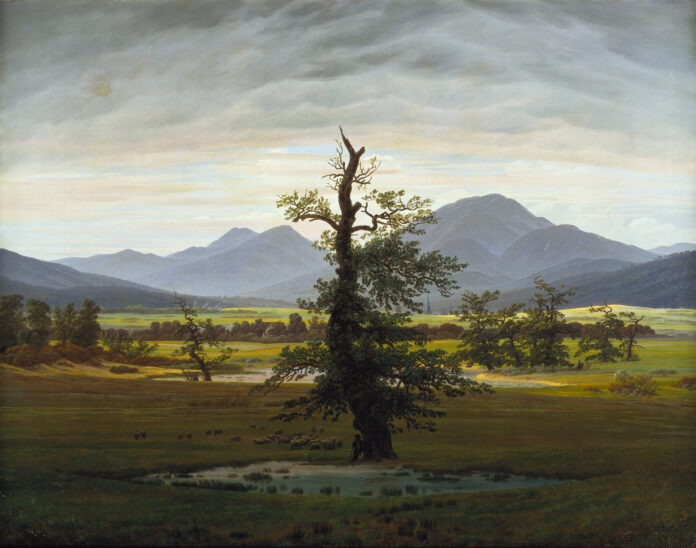Caspar David Friedrich, a renowned German painter of the Romantic era, created a captivating body of work that captured the essence of nature and its profound emotional impact. Among his masterpieces, “The Lonely Tree” stands out as a testament to Friedrich’s ability to convey solitude and introspection through landscape art. In this article, we will delve into the significance of “The Lonely Tree” within Friedrich’s oeuvre and explore the themes and symbolism embedded in this evocative painting.
Background and Context:
Friedrich’s deep connection to nature and his fascination with landscapes set the foundation for his artistic pursuits. The Romantic movement, characterized by a celebration of emotion, imagination, and the sublime, greatly influenced Friedrich’s work. Drawing inspiration from nature’s grandeur, he sought to convey the spiritual and emotional aspects of the natural world through his paintings. Friedrich’s art often featured solitary figures in vast landscapes, inviting viewers to contemplate the relationship between humanity and the natural environment.
Description and Analysis of “The Lonely Tree”:
“The Lonely Tree” portrays a solitary tree standing tall amidst a barren landscape. The composition is meticulously crafted, with the tree positioned prominently at the center, dominating the scene. The surrounding landscape is rendered with intricate detail, depicting a desolate and stark atmosphere. The play of light and shadow enhances the somber mood, evoking a sense of melancholy and solitude. The vastness of the sky above, seemingly infinite, emphasizes the tree’s isolation and the insignificance of human presence in the face of nature’s grandeur.
Friedrich’s Motivation and Intent:
Friedrich’s artistic philosophy revolved around capturing the sublime in nature, emphasizing the awe-inspiring power of the natural world. “The Lonely Tree” embodies Friedrich’s belief in the spiritual and emotional potential of solitary encounters with nature. The tree serves as a symbol of strength, resilience, and individuality, standing firm despite the barrenness of its surroundings. It invites viewers to reflect on their own inner landscapes and contemplate the transformative power of nature’s solitude.
Symbolism in “The Lonely Tree”:
The Lonely Tree” by Caspar David Friedrich is imbued with profound symbolism, inviting viewers to delve into its layers of meaning. The lone tree standing tall amidst a barren landscape represents strength, resilience, and individuality in the face of desolation. The play of light and shadow evokes a sense of duality, symbolizing the contrasting experiences of life. The vast sky above emphasizes the infinite and the transcendent. And is inviting contemplation of the sublime and our place within the grandeur of the natural world. Together, these symbolic elements encourage viewers to reflect on the power of solitude. And the transient nature of existence, and the enduring beauty found in the harmony of nature.
Reception and Legacy:
Initially, “The Lonely Tree” received mixed reactions from critics and the public. While some recognized Friedrich’s ability to convey emotions through landscapes, others found his works too melancholic and abstract. However, as time passed, Friedrich’s contributions to the Romantic movement and his unique artistic vision gained recognition. Today, Friedrich is regarded as one of the most influential landscape painters in Western art history. His emphasis on the spiritual and emotional aspects of nature continues to inspire generations of artists, and his work remains relevant and highly regarded.
Conclusion:
The Lonely Tree” is a testament to Caspar David Friedrich’s mastery in capturing the emotional and spiritual depths of nature. Through this painting, Friedrich invites us to embrace solitude and find solace in the grandeur of the natural world. The symbolic power of the lone tree resonates with viewers, reminding us of our own strength and resilience amidst life’s challenges. Friedrich’s ability to evoke introspection through his landscapes continues to captivate and inspire. And is reinforcing the enduring relevance of his work in the broader art world.
In a world often dominated by noise and constant connectivity, Friedrich’s “The Lonely Tree” serves as a powerful reminder of the restorative power of nature’s solitude. It encourages us to pause, reflect, and appreciate the beauty and significance of our individual journeys in harmony with the natural world.
And as always folks if you would like to read some of the latest articles that are both interesting and informative on a wide range of topics be sure to check out the Global Growth Forum. Also, if you would like to read some of the latest articles in Hindi be sure to check out the Mojo Patrakar.









